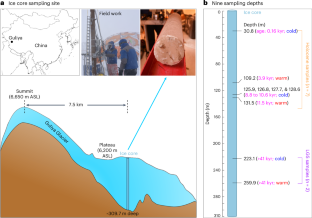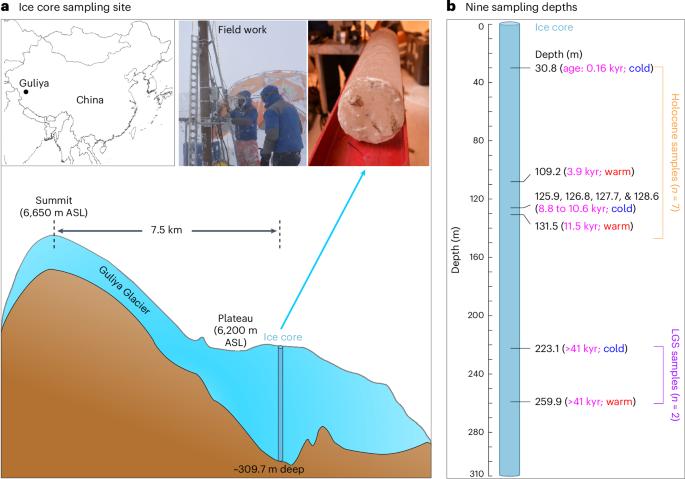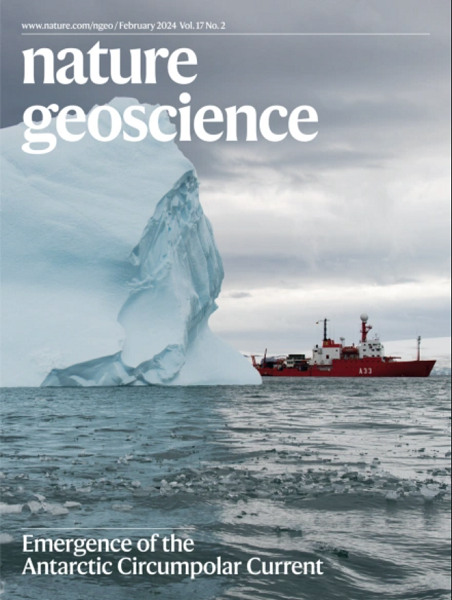Glacier-preserved Tibetan Plateau viral community probably linked to warm–cold climate variations
IF 15.7
1区 地球科学
Q1 GEOSCIENCES, MULTIDISCIPLINARY
引用次数: 0
Abstract
Glaciers archive time-structured information on climates and ecosystems, including microorganisms. However, the long-term ecogenomic dynamics or biogeography of the preserved viruses and their palaeoclimatic connections remain uninvestigated. Here we use metagenomes to reconstruct viral genomes from nine time horizons, spanning three cold-to-warm cycles over the past >41,000 years, preserved in an ice core from Guliya Glacier, Tibetan Plateau. We recover genomes of 1,705 approximately species-level viral operational taxonomic units. Viral communities significantly differ during cold and warm climatic conditions, with the most distinct community observed ~11,500 years ago during the major climate transition from the Last Glacial Stage to the Holocene. In silico analyses of virus–host interactions reveal persistently high viral pressure on Flavobacterium (a common dominant glacier lineage) and historical enrichment in the metabolism of cofactors and vitamins that can contribute to host adaptation and virus fitness under extreme conditions. Biogeographic analyses show that approximately one-fourth of Guliya viral operational taxonomic units overlap with the global dataset, primarily with the Tibetan Plateau metagenomes, suggesting regional associations of a subset of the Guliya-preserved viruses over time. We posit that the cold-to-warm variations in viral communities might be attributed to distinct virus sources and/or environmental selections under different temperature regimes. Genomes recovered from a Tibetan Plateau ice core extending back 41,000 years show that preserved viral communities varied substantially with cold-to-warm climate cycles.


冰川保存的青藏高原病毒群落可能与冷暖气候变异有关
冰川记录了包括微生物在内的气候和生态系统的时间结构信息。然而,保存下来的病毒的长期生态基因组动态或生物地理学及其与古气候的联系仍未得到研究。在这里,我们利用元基因组重建了青藏高原古丽亚冰川冰芯中保存的九个时间跨度的病毒基因组,跨越了过去 41,000 年从寒冷到温暖的三个周期。我们恢复了 1,705 个近似物种级病毒操作分类单元的基因组。在寒冷和温暖的气候条件下,病毒群落有明显的不同,在距今约11500年前,即从末次冰川期到全新世的主要气候转变时期,观察到了最明显的病毒群落。对病毒-宿主相互作用的硅学分析表明,病毒对黄杆菌(一种常见的冰川优势菌系)的压力居高不下,而且辅因子和维生素的代谢在历史上富集,这有助于宿主在极端条件下的适应性和病毒的适应性。生物地理学分析表明,大约四分之一的古利亚病毒操作分类单元与全球数据集重叠,主要是与青藏高原元基因组重叠,这表明古利亚保存的病毒子集随着时间的推移存在区域关联。我们认为,病毒群落从寒冷到温暖的变化可能归因于不同的病毒来源和/或不同温度条件下的环境选择。
本文章由计算机程序翻译,如有差异,请以英文原文为准。
求助全文
约1分钟内获得全文
求助全文
来源期刊

Nature Geoscience
地学-地球科学综合
CiteScore
26.70
自引率
1.60%
发文量
187
审稿时长
3.3 months
期刊介绍:
Nature Geoscience is a monthly interdisciplinary journal that gathers top-tier research spanning Earth Sciences and related fields.
The journal covers all geoscience disciplines, including fieldwork, modeling, and theoretical studies.
Topics include atmospheric science, biogeochemistry, climate science, geobiology, geochemistry, geoinformatics, remote sensing, geology, geomagnetism, paleomagnetism, geomorphology, geophysics, glaciology, hydrology, limnology, mineralogy, oceanography, paleontology, paleoclimatology, paleoceanography, petrology, planetary science, seismology, space physics, tectonics, and volcanology.
Nature Geoscience upholds its commitment to publishing significant, high-quality Earth Sciences research through fair, rapid, and rigorous peer review, overseen by a team of full-time professional editors.
 求助内容:
求助内容: 应助结果提醒方式:
应助结果提醒方式:


